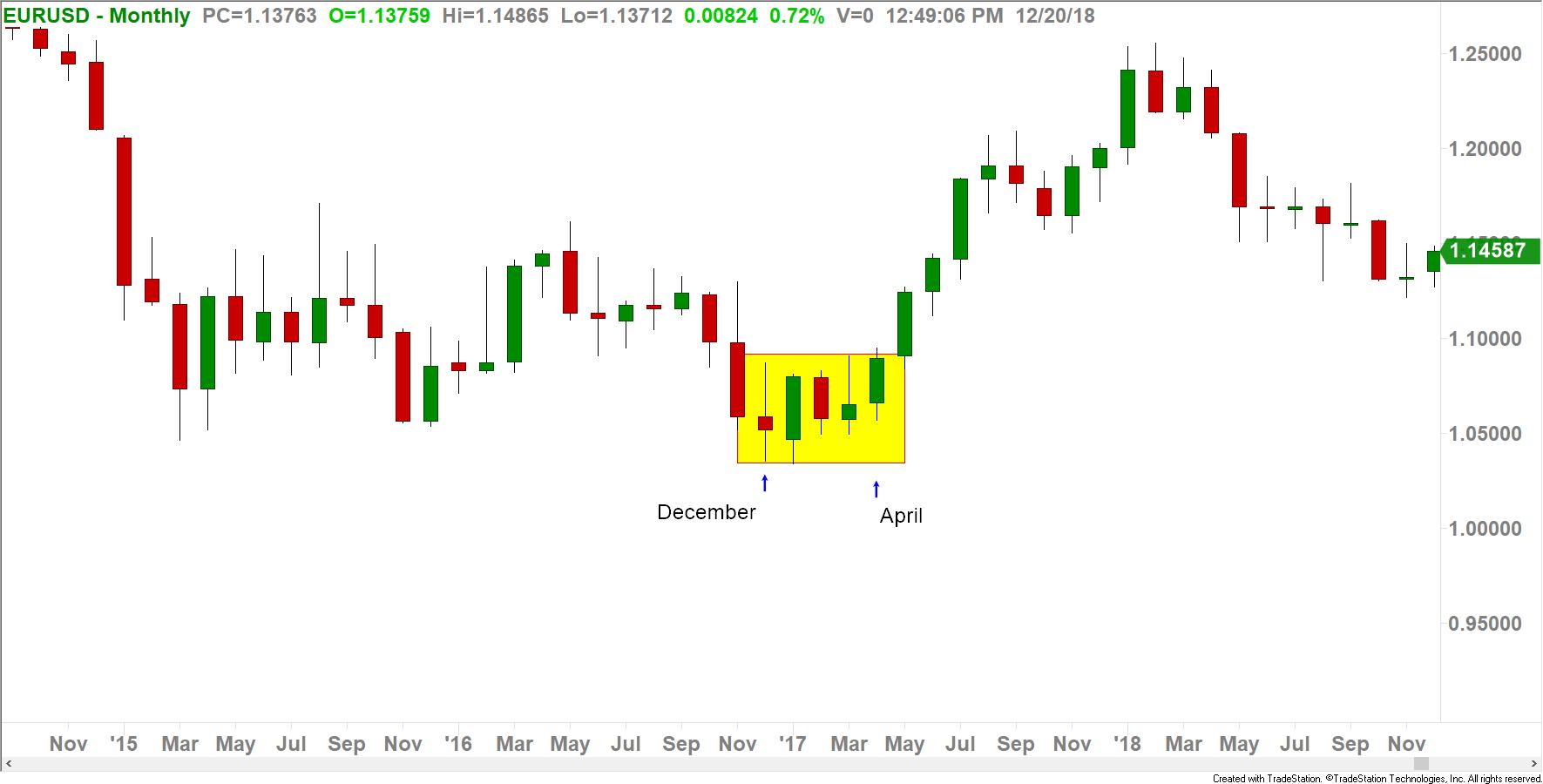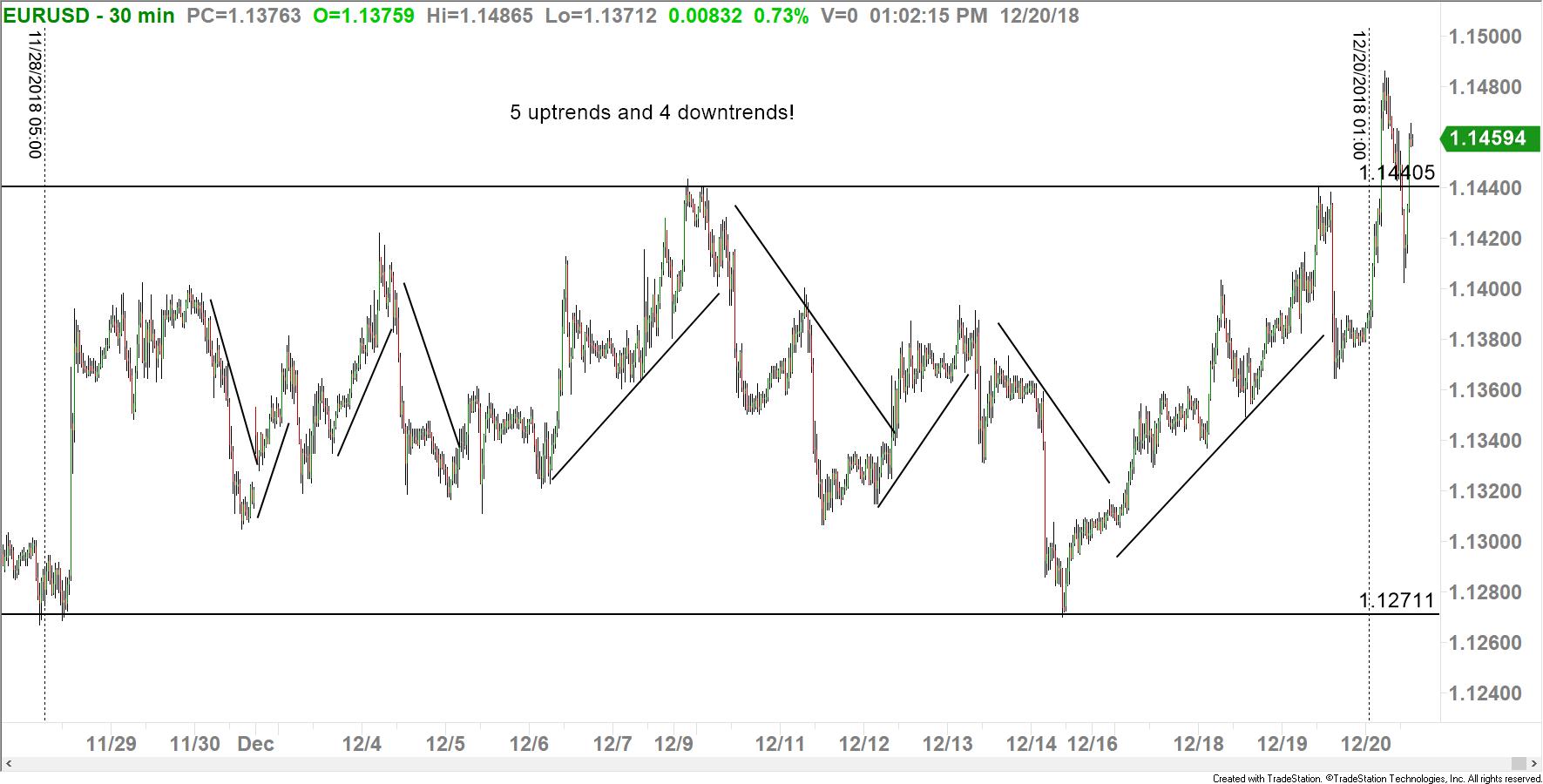Hello traders! This week’s newsletter comes to you from chilly Durango, Colorado where I’ll be hanging out for the next month or so, before my next class. Our topic this week is the need to have flexibility in your trading plan based on market conditions.
So, by now you may have heard that we consider a trading plan to be one of the most important factors in a trader’s success; but having the discipline to follow the plan is just as important! Helping with your discipline/psychology is Dr. Woody Johnson’s specialty. Here, I’ll show you an adjustment you can make to your trading plan involving timeframes that can offer a few more trading opportunities.
Different Timeframes Offer Different Opportunities
First of all, we must understand that the market moves in 3 directions: up, down and sideways. However, depending on what timeframe you use to make trading decisions, at any one time different traders will have different views of the market.
An example would be to look at the monthly chart for the EURUSD from December 2016 to April 2017. This time period is clearly a sideways market.
When dropping down to a 4-hour chart, these few months have some very clear up and downtrends to trade.
When looking at a 4-hour chart on the EURUSD from late November 28 to early December 20, we have a clear sideways trend.
When moving down to a 30-minute chart on this same period of time, there are a couple of relatively easy trades inside this smaller timeframe from up and downtrends. There are thousands of examples like these on the charts, I encourage you to go find a few on your own!
Here at Online Trading Academy, we usually use 3 timeframes for our trading: the largest is for defining where the large institutions are placing their buy (demand) and sell (supply) orders. Our next timeframe down is for defining the trend in between those larger supply and demand zones, and the smallest timeframe is where we time our entries to engage in the trend. So, what should we do when the trend isn’t clear?
The answer should be a bit obvious: change the time frames you are trading on! For example, if a weekly/daily/four-hour chart system isn’t easy to pick trades from, go down to the next series of times lower. Daily/four-hour/one-hour. And if that isn’t clear? Four-hour/one-hour/15 minute. This way your STRATEGY remains the same, just your timeframes change.
Personally, I prefer longer timeframes as the amount of time spent looking at charts is much less. Imagine using a 10 minute/2 minute/30 second strategy! A lot of time would be spent staring at the screen trying to squeeze out a handful of pips. One of the more memorable phrases in the world of trading is, “We get paid on the quality of our trades, not the quantity.” Would you rather do 4 trades a week to get 100 pips, or 400 trades a week to get 150 pips? I certainly don’t mind giving up a few pips to significantly decrease the amount of time I have to spend looking at charts!
The entire point of this article is to express the need for having a trading plan, yet also having the flexibility of adjusting a part of your plan based on market conditions, on occasion. This is where discipline comes into play. Having patience and waiting on trades that fit your plan is many times the right move. After all, if you are adjusting your timeframes every other trade, do you really have a complete trade plan to begin with? However, if the market really isn’t offering you any opportunities in your preferred timeframe, then this slight adjustment might be just what you need.
Read the original article here - Your Flexible Trading Plan
This content is intended to provide educational information only. This information should not be construed as individual or customized legal, tax, financial or investment services. As each individual's situation is unique, a qualified professional should be consulted before making legal, tax, financial and investment decisions. The educational information provided in this article does not comprise any course or a part of any course that may be used as an educational credit for any certification purpose and will not prepare any User to be accredited for any licenses in any industry and will not prepare any User to get a job. Reproduced by permission from OTAcademy.com click here for Terms of Use: https://www.otacademy.com/about/terms
Editors’ Picks
EUR/USD edges lower toward 1.0700 post-US PCE

EUR/USD stays under modest bearish pressure but manages to hold above 1.0700 in the American session on Friday. The US Dollar (USD) gathers strength against its rivals after the stronger-than-forecast PCE inflation data, not allowing the pair to gain traction.
GBP/USD retreats to 1.2500 on renewed USD strength

GBP/USD lost its traction and turned negative on the day near 1.2500. Following the stronger-than-expected PCE inflation readings from the US, the USD stays resilient and makes it difficult for the pair to gather recovery momentum.
Gold struggles to hold above $2,350 following US inflation

Gold turned south and declined toward $2,340, erasing a large portion of its daily gains, as the USD benefited from PCE inflation data. The benchmark 10-year US yield, however, stays in negative territory and helps XAU/USD limit its losses.
Bitcoin Weekly Forecast: BTC’s next breakout could propel it to $80,000 Premium

Bitcoin’s recent price consolidation could be nearing its end as technical indicators and on-chain metrics suggest a potential upward breakout. However, this move would not be straightforward and could punish impatient investors.
Week ahead – Hawkish risk as Fed and NFP on tap, Eurozone data eyed too

Fed meets on Wednesday as US inflation stays elevated. Will Friday’s jobs report bring relief or more angst for the markets? Eurozone flash GDP and CPI numbers in focus for the Euro.
RECOMMENDED LESSONS
Making money in forex is easy if you know how the bankers trade!
Discover how to make money in forex is easy if you know how the bankers trade!
5 Forex News Events You Need To Know
In the fast moving world of currency markets, it is extremely important for new traders to know the list of important forex news...
Top 10 Chart Patterns Every Trader Should Know
Chart patterns are one of the most effective trading tools for a trader. They are pure price-action, and form on the basis of underlying buying and...
7 Ways to Avoid Forex Scams
The forex industry is recently seeing more and more scams. Here are 7 ways to avoid losing your money in such scams: Forex scams are becoming frequent. Michael Greenberg reports on luxurious expenses, including a submarine bought from the money taken from forex traders. Here’s another report of a forex fraud. So, how can we avoid falling in such forex scams?
What Are the 10 Fatal Mistakes Traders Make
Trading is exciting. Trading is hard. Trading is extremely hard. Some say that it takes more than 10,000 hours to master. Others believe that trading is the way to quick riches. They might be both wrong. What is important to know that no matter how experienced you are, mistakes will be part of the trading process.




